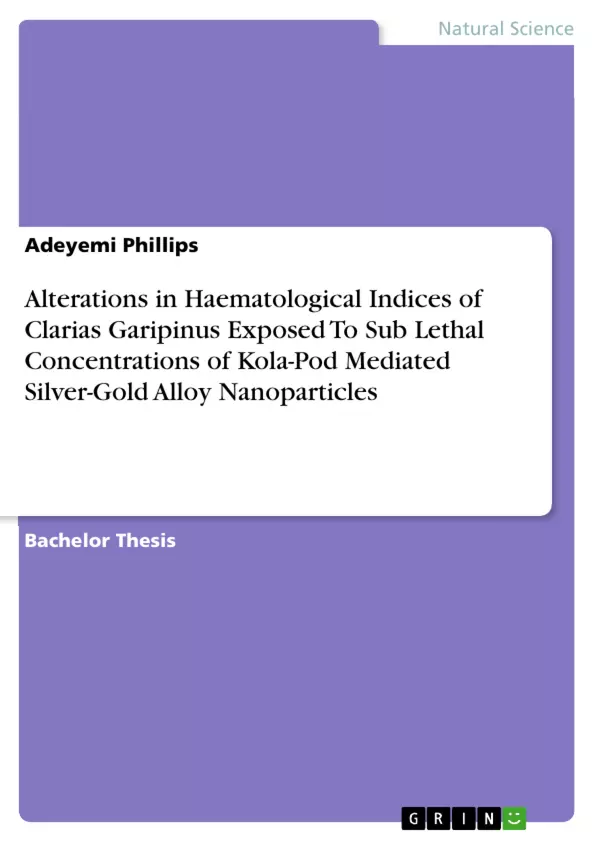Nanotechnology is an anticipated manufacturing technology that allows the long established trend toward smaller, faster, cheaper materials and devices. The high demand for nanoparticles implies more production of which the waste products are discharge into the environment. This might have toxic effects on biotic factor especially aquatic organism. This study thus evaluates the effects of silver salt, gold salt and silver-gold alloy nanoparticles were investigated on juvenile Clarias gariepinus. Sub lethal concentration (5ng/ml, 100ng/ml and 250ng/ml) were evaluated on haematological indices (the Hb, RBC, PCV, WBC, MCV, MCH and MCHC) of the fish for an exposure period of 42 days. Blood samples were collected on the 14th, 28th and 42nd day of the exposure. Exposure of Clarias gariepinus to each concentration, caused a dependent significant (P < 0.05) reduction in the values of Hb, RBC, PCV, MCH, MCHC. However, there was a gradual increase in the values of WBC and MCV as the concentration of the silver salts increased. These alterations were more pronounced in the fish exposed to 100ng/ml of gold salt, 250ng/ml silver salt and 5ng/ml of the alloy. Results from this study suggest that brief exposure of Clarias gariepinus to nanoparticles could cause some level of stress as manifested by changes in the haematological parameters of fish under consideration.
Inhaltsverzeichnis (Table of Contents)
- CHAPTER ONE
- INTRODUCTION
- NANOTECHNOLOGY
- NANOPARTICLES
- PHYSICAL METHODS OF SYNTHESIZING NANOPARTICLES
- CHEMICAL METHOD
- BIOLOGICAL METHOD
- NANOPARTICLES TOXICITY ON FISH
- AIMS AND OBJECTIVES
- INTRODUCTION
- CHAPTER TWO
- LITERATURE REVIEW
- CHARACTERIZATION
- HAEMATOLOGICAL INDICES OF THE AFRICAN CAT FISH, Clarias garienpinus......
- LITERATURE REVIEW
- CHAPTER THREE
- MATERIALS AND METHODS
- BIOGENIC SYNTHESIS OF SILVER-GOLD ALLOY NANOPARTICLES.........
- COLLECTION OF TEST ORGANISM
- ACCLIMATIZATION OF FISH
- BLOOD SAMPLE COLLECTION FROM FISH
- PACKED CELL VOLUME (PCV)
- HEAMOGLOBIN (HB)
- RED BLOOD CELL (RBC)
- WHITE BLOOD CELL
- MEAN CELL VOLUME (MCV)
- MEAN CORPUSCULAR HEAMOGLOBIN (MCH)
- STATISTICAL ANALYSIS
- MATERIALS AND METHODS
- CHAPTER FOUR
- RESULTS
- CHAPTER FIVE
- DISCUSSION AND CONCLUSION
- DISCUSSION....
- CONCLUSION
- DISCUSSION AND CONCLUSION
Zielsetzung und Themenschwerpunkte (Objectives and Key Themes)
This research aims to evaluate the impact of silver salt, gold salt, and silver-gold alloy nanoparticles on the haematological indices of the African catfish, Clarias gariepinus, with a focus on the potential toxicity of these nanomaterials to aquatic life.
- The synthesis and characterization of silver-gold alloy nanoparticles using biogenic methods.
- The impact of exposure to sublethal concentrations of silver salt, gold salt, and silver-gold alloy nanoparticles on the haematological indices of Clarias gariepinus.
- The potential toxicity of nanoparticles to fish, particularly in relation to haematological parameters.
- The development of eco-friendly and sustainable methods for the synthesis of nanomaterials.
- The importance of studying the impact of nanomaterials on aquatic ecosystems and the need for further research in this area.
Zusammenfassung der Kapitel (Chapter Summaries)
Chapter One: Introduction
This chapter introduces the concepts of nanotechnology and nanoparticles, highlighting their wide-ranging applications in various fields, including medicine, electronics, and biosensing. It discusses the properties of silver and gold nanoparticles and their importance in engineered nanoplatforms. The chapter also discusses the different methods used to synthesize nanoparticles, including physical, chemical, and biological methods, focusing on the advantages and disadvantages of each method. Finally, it outlines the aims and objectives of the research project, which is to assess the effect of exposure to silver salt, gold salt, and silver-gold alloy nanoparticles on the haematological indices of the African catfish, Clarias gariepinus.
Chapter Two: Literature Review
This chapter provides a comprehensive overview of the current research on the haematological indices of the African catfish, Clarias gariepinus, as well as the potential impact of nanoparticles on aquatic life. It explores the physiological significance of haematological indices and how they can be used to monitor the health status of fish. The chapter also discusses the potential toxicity of nanoparticles to fish and the need for further research in this area.
Chapter Three: Materials and Methods
This chapter describes the materials and methods used to conduct the research. It includes detailed information on the biogenic synthesis of silver-gold alloy nanoparticles, the collection and acclimatization of the test organisms (Clarias gariepinus), and the blood sampling techniques used. The chapter also outlines the procedures followed to analyze the haematological indices of the fish.
Chapter Four: Results
This chapter presents the findings of the research, highlighting the results of the haematological analysis of the African catfish exposed to silver salt, gold salt, and silver-gold alloy nanoparticles.
Schlüsselwörter (Keywords)
Nanotechnology, nanoparticles, silver nanoparticles, gold nanoparticles, silver-gold alloy nanoparticles, biogenic synthesis, haematological indices, Clarias gariepinus, African catfish, toxicity, aquatic ecosystems, environmental impact, eco-friendly, sustainable, research.
- Quote paper
- Adeyemi Phillips (Author), 2017, Alterations in Haematological Indices of Clarias Garipinus Exposed To Sub Lethal Concentrations of Kola-Pod Mediated Silver-Gold Alloy Nanoparticles, Munich, GRIN Verlag, https://www.grin.com/document/475214



